7 Section 3.1: Circle of Fifths
The first item up for study in the area of harmony should be the CIRCLE OF FIFTHS. This is a graphic representation of harmonic motion based on intervallic relationships shared by different notes and tones used in making music. Beginning at the top with the note ”C” we use the musical alphabet to move clockwise in intervals of a Perfect 5th (P5), thus the term Circle of Fifths. If we start with “C” again but move counterclockwise we find that the intervallic motion is in Perfect 4th (P4). These are the first patterns we see in the circle of fifths chart. It shows us Key Signatures, harmonic motion, and the mathematical relationship of all keys and how they can interact together.
The capital letters around the outside of the circle represent MAJOR key areas, while the lowercase letters around the inside represent the MINOR key areas. Each major has a corresponding minor that shares the same key signature denoted by the number of sharps (in red) and flats (in blue) for each area. Notice that when we move around the circle in clockwise motion we add a sharp to each key. Once we reach the bottom we have effectively altered every available note so we can no further add sharps. We use the ENHARMONIC version of the tone to pivot from sharp to flat so that instead of adding, we take away flats until we reach C again where there are no sharps or flats.
Once the student has learned the Circle of 5ths, they should start to look at mathematical patterns and relationships. For example, the Blues form uses three chords, I, IV and V of a tonal area. If C is our home key or tonic, where the song starts, then the IV is F which is on the left of C and the V is G which is on the right of C. This pattern exists at every location on the wheel. Every chord progression known can be tracked and studied through the Circle of 5ths if we spend enough time with it. That is exactly what the student must do is be diligent in their practice and spend time using the Circle of 5ths during instrumental practice and music theory study. Deciphering the Circle of 5ths will take some time and practice but is well worth the effort if one remains disciplined and focused.
Composers build harmonic progressions based on the relationships displayed in the Circle of 5ths or the mathematical patterns that exist within it. This is why we need to spend time with it and learn how to apply it to our performance practice.
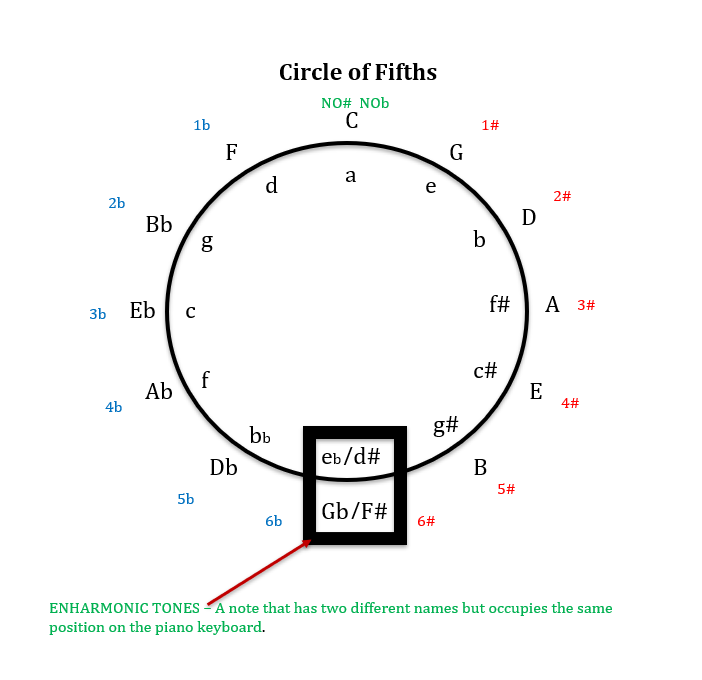
ENHARMONIC TONES
Enharmonic tones play an important role in the composition and communication of music as a language. Just as the English language has grammar, syntax, and style, so does the language of music. Enharmonic tones provide the necessary flexibility in constructing melody and harmony needed to communicate a musical phrase to the listener. Building scales and constructing chords have rules that demand multiple labels for the same note depending on how and when it is used within a key area. G-flat and F-sharp geographically on the keyboard are the exact same pitch; however, there are no G-flats in F-sharp Major or Minor because we must abide by the original rule of scale construction. Using alphabetical order, we must have each note represented for the completion of a scale. Therefore, there must be F#-G#-A#, etc., and no G-flats, they cannot exist within this usage.
The Circle of Fifths is a very important part of serious music study, no matter the level. In order to properly unlock the secrets of this tool, one must spend a large amount of time using a technique I call “putting your eyes on the chart”. Don’t just stare at it blankly, but look at the chart intensely, with deliberate intention to identify patterns that comprise harmonic motion. The next logical conclusion is that there must be other relationships on the wheel based on multiple principles that have not yet been introduced, which means that the Circle of Fifths will always yield material for academic study and compositional substance.
The name of the symbol, the Circle of Fifths, gives us the understanding that music can move in fifths. An easily recognizable pattern based on its name so it is the harmonic first pattern we learn. As mentioned earlier, if we reverse the direction and move in counterclockwise motion we begin to see that the intervallic motion unfolds in fourths.
In mathematical study, we learn that if one pattern exists within a series, then there are more patterns based on simple relationships within the existing integers. The more one studies or “puts their eyes on the chart”, the Circle of Fifths reveals more musical secrets. As more patterns are identified, harmonic motion becomes easier to understand and use. To discern which notes are altered with accidentals we use the formula to build a scale and find out the key of G has one sharp which is F#. From here the math is to add one sharp every turn on the wheel while retaining the previously altered tones, gathering accidentals as we move. However, we can also put the order of sharps and flats in a way that we can study away from the chart in order to memorize which is useful when put together with other aspects of music theory study: #=F,C,G,D,A,E, B – b=B,E,A,D,G,C,F. Notice the intervallic space between each sharp note is a fifth and each flat note is a fourth, another way to define the math of the chart. The more we use the Circle of Fifths we will begin to unlock all sorts of patterns that govern and define chord movement in all genres of music.
As this text unfolds, we will explore the deeper relationships of the Circle of Fifths and how they govern and describe harmonic motion. This can become complicated when studying more complex chord movement and tonal relationships. For now, we will diverge momentarily to look at chords and chord construction in order to unlock more patterns that seem to hide from the beginning music student.
The first thing we learn about HARMONY is that it is intended to be used in a supportive manner for reinforcing the melody of a song. So, HARMONY as a working definition is the simultaneous performance of multiple tones intended to support a melody. Further we will learn that the types of harmony used in a song will also be used for KEY identification to define a specific tonal area. The word signature is added to the word Key to form a phrase musicians use to communicate verbally and in graphic notation what is known as a KEY SIGNATURE. The arrangement of sharps and flats for each tonal area is its Key Signature.
The simple definition of melodic support is useful until we arrive at the Romantic period and 20th Century of music history when studying composition as an art form. Composers of this period learned how to manipulate the rules that govern harmonic motion and apply new ideas to that end. As a result, many composers began to use and develop harmonies in the same manner that they developed melodies. They began to use harmonies to represent feelings they wished to evoke in the listener, to represent a character within a story, or to represent a particular emotion or psychological connection. Bringing harmony and melody in and out of the musical texture this way defies many of the rules established by the masters. These new rules and the old ones made it all the way into 20th Century music. These composers would take melody and harmony and begin to manipulate them through extra-musical means like math and science.
OVERTONE SERIES
The overtone series is described as the presence of multiple notes that reside within one note called the FUNDAMENTAL. This series is a mathematical subset that outlines the texture and TIMBRE, or sound quality, of a musical note observed by the listener. That mathematical subset is called HARMONIC CONTENT. It is also known as THE OVERTONE SERIES, HARMONICS, and PARTIALS. When Overtones are observed and studied, we see that the Fundamental pitch occurs more times in the series than any other. These multiples heard together build a louder dynamic or amplitude than the remaining harmonic content, this is why we can hear and identify a fundamental tone. It occurs the most in the math, therefore it has a greater amplitude than any other note in the series. The following diagram is a small isolation of harmonic content in the lower portion of the entire mathematical range, it is intended to give the student a visual of this intangible process that governs music-making. We see the main pitch “C” or the FUNDAMENTAL, the note our ears recognize as a singular pitch because it occurs the most in the mathematical pattern therefore it has more amplitude than the other parts of the series.
Different terms are used in different contexts when referencing HARMONIC CONTENT: For wind instruments, the term PARTIAL is used because the performer is literally isolating parts of the instrument to create a higher or lower tone. In order to change notes, the instrument must be manipulated in a way that elongates or shortens the length of the instrument to raise or lower a pitch, i.e. valves on a trumpet, the slide of a trombone, or the keys on a woodwind instrument. When performing on a string instrument, we refer to them as HARMONICS because these are easily found on the string and are a division of the string itself. If, however, we are performing tasks purely based in music theory we use the term OVERTONE SERIES.
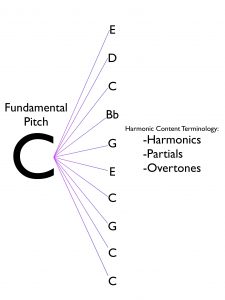
This phenomenon that occurs naturally in all music helps us to identify which chords go with that melody and vice versa. The series also helps us determine which chords can follow or precede a chord that creates a sense of agreement or disagreement within the music. When we observe the disagreement the musical term we use to identify it is called DISSONANCE. When the listener can observe agreement between tones it is identified as CONSONANCE. Consonance is always used to announce the ending of a phrase or the completion of a musical work.
CHORDS
In order to understand complex harmonic motion in a deep manner, it is necessary to start with the simplest chord used in music construction: the TRIAD. A triad, simply put, is a three-note chord. The example below demonstrates the graphic representation of a triad on a staff and the names we use to identify notes of which they are constructed.
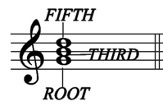
This G major triad outlines the three components the theory student must know in order to study harmonic motion. Later in harmonic study, we use chord extensions in which we add multiple tones to the chord past the 5th which alters the quality of sound. But before that happens, we must build a solid foundation in the basics.
The ROOT is the most important and is generally found in the BASS sections of an ensemble. Without it we do not know how a particular chord will function within a larger soundscape. The 3rd, the second most important tone within a triad, tells the listener what type of chord they are hearing, major or minor. Without a third TONAL AMBIGUITY arises and makes it hard for the listener to determine the musical Flavor and process what they hear. The fifth is the least important and can sometimes be omitted from use altogether depending on the musical situation. These rules will be discussed in the section covering Diatonic Harmony later in the text; for now, learn the different parts of the triad and be able to identify them when presented.
CHORD CONSTRUCTION
There are two ways to construct and analyze a triad. The first is by using the alphabet to spell out the chord. Start with the first pitch given and skip every other letter until you get to the fifth. So, to construct a G major triad one would start with the note G, skip A, use note B, skip C, and use D, thus Root -Third – Fifth.
The second technique is by identifying the intervallic construction of a chord. A triad is built with two intervals stacked on top of one another. The bottom being an interval of a Major 3rd with a Minor 3rd on top for major and the reverse for minor. Understanding the arrangement of intervals inside chord construction is an important skill to have when studying harmonic motion and identifying chords in a musical work.
MAJOR

MINOR

One can build triads on any musical note by following the previous formulas. It is the music student’s responsibility to become familiar enough with chord construction that they can identify triads by sight and sound.
Further, it is worth noting that communicating a triad in written form on a staff gives it an artistic shape as well. With the root on a line of the staff the next two notes must be placed on the next two lines in order. This establishes a shape in which even if one doesn’t know which chord they are studying they should be able to identify the fact it is a triad. By the same reasoning, we know that if the root of a chord is on the space of the staff then each part of the chord must be placed on a space as well. Recognizing spatial differences on a staff is important when performing music theory analysis.
DIATONIC HARMONY
DIATONIC HARMONY is a system of rules that govern the use of chord progressions. This system was designed to give the listener the greatest sense of finality at the end of a piece, clearly outline smaller units within a larger format, and provide structural reinforcement at impact points within a composition. Composers and theorists alike abide by these rules when writing four-part harmony, arranging for bands or orchestras, and composing original songs. Learning how, when, and why to use a specific chord will also teach us about melodic construction and the use of tonal areas to evoke a specific emotion in the listener. These rules were solidified during the Classical Period of music history. However, through inventive use by songwriters these rules made their way into the first forms of American Popular Music. Over time songwriters and composers would begin to bend and break these rules according to their musical needs.
The best way to begin the study of Diatonic Harmony is to understand chord placement within Major and Minor scales. Each part of the chord has a specific function based on musical context. To understand that context we start with Triads positioned on a scale degree within the Major Scale which demonstrates the tonal hierarchy that exists in the Diatonic Harmony system.
C-MAJOR

Each note of the scale as an individual tone is referred to with Arabic numerals (the numbers we normally use when writing in English), and when a chord is built on one of these notes we refer to it with Roman numerals. The upper case Roman numerals refer to Major chords and the lowercase numerals refer to minor chords. There is one exception on the seventh scale degree that we refer to as DIMINISHED because its intervallic placement within the scale forces it to have a minor third and a lowered fifth, thus the term diminished. Each chord is also referred to by a name that determines its function in Diatonic Harmony. Remember from scale study that music is patterns and can be repeated. So, it is worth noting that the chords in the diagram are always in the same arrangement as long as the scale is Major. In other words, in Major scales I, IV and V are always major while ii, iii and vi are minor chords with the seventh being our diminished chord or SUB-TONIC.
A NATURAL MINOR

Notice that in a minor scale the chord order is reversed placing major where minor existed within the major scale.
The word TONIC refers to the “HOME” chord because it is built on the first note of the scale. This chord will begin and end every musical composition for structure and finality. This is the most important chord in the entire scale.
The next two most important chords are IV and V. These two chords help to establish TONAL or KEY areas that are defined by the use of the chords. The four is referred to as SUB-DOMINANT and is named so because it precedes the V chord in music compositions to prepare the listener for the V or DOMINANT chord. Both these chords can lead back to the TONIC key for structure and harmonic definition.
SUPERTONIC, SUBMEDIANT and MEDIANT chords are called “PREPARATORY HARMONIES.” They precede SUBDOMINANT or DOMINANT chords; composers use these to extend sections or lead the listener to a specific moment or emotion.
The diagrams below illustrate the harmonic movement allowed within the rules of Diatonic Harmony.
Rule 1: I can go to any chord and any chord can go to I.
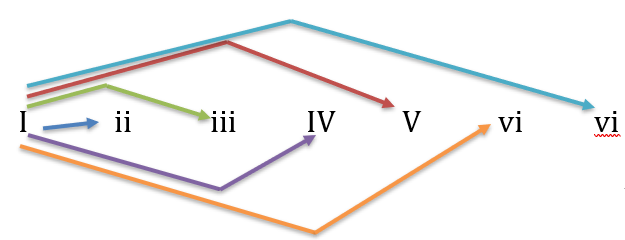
Rule 2: In the system of diatonic harmony V (Dominant Harmony) can only move to I. This is the strongest resolution and is used to mark the end of a section or the end of an entire song.

Rule 3: In the system of diatonic harmony IV (Subdominant Harmony) chord can go to V or I, but V can never go to IV.

Rule 4: Subdominant Harmonies are any harmony that can move from I to V in order to prolong harmonic motion and provide color and texture change within a composition. This means that ii (Supertonic) goes to V which then leads to I.
I – ii – V – I
Rule 5: Submediant harmonies precede Mediant chords. This means that iii goes to vi and vi can move to ii which always precedes V which always goes to I.
iii – vi – ii – V – I
As long as the harmonies involved are basic like the Triad, then the first set of rules work well. However, composers are known to add more notes to a chord to thicken up the overall sound. Once we begin to add tones to a chord we have more to keep up with when writing harmonies for multiple voices or orchestrating a work for a large ensemble. When writing music with moving multiple moving parts, the composer is forced to adhere to a subset of rules in Diatonic Harmony called VOICE LEADING. This is a phrase used in music to refer to the outer and inner movements in harmony that occur over the course of a musical work. Here is a good spot to learn about CONSONANCE and DISSONANCE. These two terms are used to describe the workability in an aural setting of certain tones. Another way to say it is the agreement and disagreement of tones or chords. Dissonance is the disagreement of musical tones and is used to create tension within a composition. Consonance is the agreement of tones and describes the resolution of the musical disagreement.
To build dissonance and tension within a composition composers add a tone to chords after the triad is formed, this note is called the 7th. It is called this because it is seven steps away from the root. Four toned chords with 7ths are difficult to control because they have to be resolved in a particular way. When the Dominant 7th is present it creates an interval within the larger chord called a TRITONE. The TRITONE has a lot of bite and is extremely dissonant. When this is used the 3rd and the 7th must resolve by stepwise motion in opposite directions.
MAJOR, MINOR AND DOMINANT CHORDS
Music is math and math is patterns; any pattern can be altered or manipulated based on a predetermined set of rules. The beginning theory student should begin with the first two that they will encounter in common performance use: MAJOR and Minor triads. The more notes contained within a chord, the more complex it becomes and how complex it is will determine its function and manipulation.
The following examples show the seventh chord in its three forms in root position. This means the tone that describes the chord is on the bottom of the voicing and the rest of the chord is constructed in ABC order so it stacks up right on top of one another on the staff.
First is the Major seventh chord. It is named such because the added tone comes directly from the Major scale. It is consonant so it has a pleasant sound aurally and is used as such when a composer wishes to convey a corresponding emotion or tone color.

If we lower the 7th one half step we get a dominant harmony with the TRITONE dissonance discussed earlier.

his chord is referred to as dominant because of the arrangement of intervals that function as “key defining intervals.” In other words, these intervals aurally lead the listener to a point of rest or repose within a musical work. These chords can mark structure and form, demonstrate drama, thicken texture, and even represent an emotion. The presence of the tritone requires us in diatonic harmony to “resolve” the tension the interval presented. The dominant chord is a very important chord in both major and minor fields of scale and harmony. For now, identifying it is our goal. Ultimately, one must learn to use it within the confines of the genre of music in which one is working.
Lowering the 3rd one half step with the 7th lowered gives us a Minor seventh chord. This chord has a particular color to it that distinguishes it from the previous two examples.
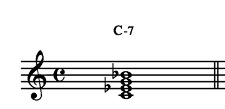
In Diatonic Harmony, there are a number of rules that apply to the usage of a specific tone or specific chord. There are also a number of rules that determine which of these notes can be used with a particular chord or follow and precede a tone or chord. This book is not intended to be a thorough study of diatonic harmony or voice leading; for that, the student should look to a method that covers those topics specifically. What we should discuss as beginners is that the more tones one adds to a chord the more one has to keep track of, similar to a playwright who has many subplots within the larger structure. Musical tones represent characters all with their own story arc and trajectory.
In popular music we adopt many chord progressions from diatonic harmony, but usually with a twist unique to the performer. If one were to analyze the earliest forms of American Popular Music they would find diatonic harmony spattered about like batter on the kitchen wall. Pop musicians figured out how to “jailbreak” diatonic harmony and manipulate chords through other means by disregarding diatonic principles altogether while simultaneously using one or two rules for the end or beginning of a song for emphasis. Eventually Popular Music composers would throw Diatonic Rules to the side and construct chord progressions of their own design, thus giving rise to American song form and harmonic structure of Western Popular Music.
The first place in America we look is at the Blues music that originated in the South on plantations in the form of field hollers. This technique utilized the “call and response” method of communicating. A leader sings a small phrase while the group sings it back to the leader as if to answer a question. Harmonically the Blues breaks the most important diatonic harmony rule by moving from V to IV to I in the last section of the form. The first two sections of the Blues form are considered the call and response with the last section of new lyrics that lead us through the story or to the next set of lyrics. Rock and Roll and Country music would be born out of this marriage of musical approaches. As music progresses through history it evolves with every technological advancement and every intellectual advancement made by a composer or musician. For this reason, the theory student must be familiar with multiple forms of music and with the distinctions and the relationships they share.

